Palm Trees from around the World
For years I have wondered why palms are not present in all homes where house plants are enjoyed. I have about come to the conclusion that price and a general misunderstanding about these wonderful plants are the main culprits. The price for a developed palm plant can be quite staggering. Even the smallest palm in a five gallon container can cost around twenty-five to fifty bucks. A mature tree palm delivered to your home can cost from several hundred to several thousand dollars.
A misconception about palms is that they will only grow in the tropics and deserts. While it is true that many of the over three thousand species of palms do thrive in these hot humid areas, it is also true that some are quite cold hardy and with some degree of protection can be raised in areas where it freezes. And it is very true that almost every palm makes a good houseplant although some of the tree types will eventually out grow their limited surroundings.
Another unknown about palms it that they can be easily raised from seed at a cost of less than a dollar each. They require little maintenance and add beauty and value to your home.
Here is a selection of my favorite palms. I hope you will try a few.

This palm may reach an ultimate height of 50-60 feet with a spread of 20 feet or more. Even young specimens that have yet to form a trunk sport full crowns of about 25 leaves with the maximum spread. The huge palmate leaves are bright light blue, waxy and are up to 10 feet across. They are supported on 6 foot. stems that can be 10 inches in diameter. The leaf bases split where they attach to the trunk and the leaf stems are armed with small sharp teeth.
This palm is adaptable to many kinds of soil.It prefers full sun but is tolerant of some shade. Once established this palm is drought tolerant.
USDA Zones 10 - 11. Bismarck palm can be grown in the warmer parts of Zone 9 where it is occasionally damaged by freezing temperatures from which it can recover in a season.
Because of its huge ultimate size and mass, the Bismarck palm is not recommended for small yards as it dominates its space, dwarfing and obscuring adjacent structures. This palm is best planted where it can serve as a focal point. Planted against a dark backdrop of foliage, it serves as living sculpture adding drama and interest to the landscape.

This elegant palm is great for small yards and can also grow indoors in containers in cooler climates, makes a wonderful patio plant. This is a very attractive, slow growing palm that can get up to 6-8 feet tall outdoors in warm climates, with a spread of 4 feet wide. It has a single slender trunk, 4-5 inches in diameter that takes years to develop.
The Ruffled Fan Palm is known for its unique palmate, or fan-shape leaves, with attractive splitting patterns that make it stand out in any environment. Leaves are circular, luscious green, glossy, ruffled, hence the name Ruffled Fan Palm, about 22 inches in diameter, with notched tips.
It grows best in partial shade and should not be exposed to full sun. Also, make sure to protect it from high winds to avoid frond damage. It needs a lot of water with good drainage. It can tolerate cold down to 30F when mature.
Seed Germination: These seeds inherently have a low germination rate, expect 30-40 percent in most cases.

As indicated by its habitat and by experience from cultivation, it is by far the most cold tolerant Fishtail Palm, guaranteed to stand up happily to cold winters with snow and moderate frosts to 19°F.

It is the canopy of fronds that really sets this Phoenix palm apart from the rest. The leaves, which grow to about 10 feet long are bright green color and are arranged in plane on the stem which gives the fronds a flat appearance that combined with their unique, natural curving, arching and twisting form results in a very graceful palm.
The purplish red fruit is about 0.75 inch long and has a thin layer of edible flesh although the fruit is not this palm's best quality.
The cliff date is a very ornamental palm and therefore is mainly used as an accent or specimen palm in both residential and commercial landscapes in warm climates. This is a very beautiful palm for zones 10-11, or as a patio plant.

It is highly drought tolerant but will also do well in cold and humid conditions. It does not need hot summers to grow well and in winter it can take severe frost down to -16°C (3°F) unharmed. For many temperate climates it is the only large pinnate palm which is cold-tolerant enough to be successful long-term. Many fine, centennial examples can be admired for instance in California, Australia and along the Mediterranean, in southern Switzerland, along the windy Atlantic coast of France and even in Britain. And there are many other areas where it would do well but has not been tried much.
Germination and establishment are slow but easily accomplished and young plants are sought after and of high value as they are rarely found in the nursery trade.

Royal palms provide a sophisticated look to thoroughfares throughout the Caribbean. Assembled into a grove on an expanse of lawn, Royal Palms create an eye-catching focal point.
The Royal Palm is native to the cypress swamps of south Florida. It is disappearing from the wild but nice stands can still be seen at the Royal Palm Visitors Center near Homestead, Florida in the Everglades National Park.
Roystonea regia is a large palm which reaches a height of 60 to 100 feet tall and a stem diameter of about 20 inches. The trunk is stout, very smooth and gray-white in color with a characteristic bulge below a distinctive green crownshaft. Trees have about 15 leaves which can be up to 13 feet long. The flowers are white with pinkish anthers.
Hardy for zones 10 and above.


Cabbage Tree tolerates a wide range of soils ranging from wet boggy conditions to dry ones. If grown outdoors, it does best in moist, fertile, organically rich, well-drained soils in full sun to part shade. When grown in containers outside on patios in summer, it can be brought in over the winter or grown indoors year-round as a houseplant. If grown in a container, keep soils consistently moist in summer but reduce moisture indoors in winter and site the plant in bright sunny spots in the home or greenhouse. Also note that container-grown plants rarely flower.
Cabbage Tree has a taproot that needs the root space of a large and deep container for best growth. Young plants consisting of a fountain of grass-like leaves with no trunk are often sold as houseplants. Zones 8-11, or inside plant for colder zones.
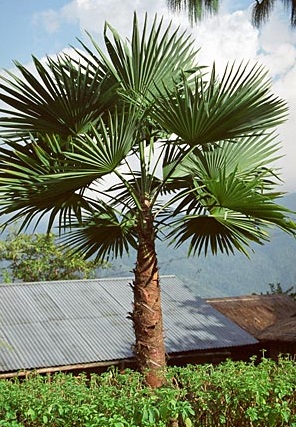
It is commonly known as Windamere palm, for the locality where its first botanical description was made, the garden of the famous Windamere Hotel in Darjeeling, India. It was formally photographed and collected for the first time only in 1992 during the Royal Botanic Garden Edinburgh Sikkim Expedition. It is considered a temperate palm, and has been reported to withstand a wide range of climates, from tropical, subtropical to cold and wet conditions. It is native to Sikkim in the Himalayas, where it has been reported from a range of elevation between 3500 to 7000 feet. It remains in the wild in just one tiny, heavily altered location which is immediately threatened by deforestation. Cold hardy to about 28 degrees.

This slow-growing plant provides a decorative tropical touch to any setting with its upright gray trunk that is topped by handsome bright green fronds. Over time the trunk forms a distinctive thicker section in middle that resembles the shape of a spindle, thus the common name of Spindle Palm.
A spectacular potted plant for large indoor spaces with bright windows. Can also be grown outdoors in a patio planter during the summer and brought indoors for the winter. Zone 10 and above outside.

Kentia palms tolerate and adapt to a wide variety of soils including those that are neutral, acidic, clayey and slightly alkaline, but they perform best in rich loamy soil with excellent drainage. Kentia palms are traditionally slow growers, however regular fertilization with palm-grade fertilizer promotes maximum growth. A balanced (e.g., 18-18-18) slow-release palm fertilizer with minor elements should be used during the growing season. Magnesium and potassium nutritional deficiencies have been noted, particularly in older kentias. Mineral supplements should be administered in recommended amounts to prevent or treat such deficiencies. Kentia palms in pots or tubs can be left in the same container for many years due to their slow growth.
USDA Zones 9B - 11. Considered cold hardy in frostfree locations. Mature and established specimens can tolerate occasional temperatures down to 25ºF (-4ºC) without incurring significant damage to foliage.


The Clustered Fishtail Palm is probably the most widely grown of its kind, and for good reason. This foliage plant germinates and develops quickly, becoming an attractive, bushy, medium-sized palm, sporting many dark green, bipinnate leaves with fishtail-shaped leaflets that are unique to Caryota.
It is native to Southeast Asia. It is a well-tested, easy-to-grow, and really reliable palm, and will grow in nearly any frost-free climate from warm temperate to tropical.
Best suited outside for zones 9-10.

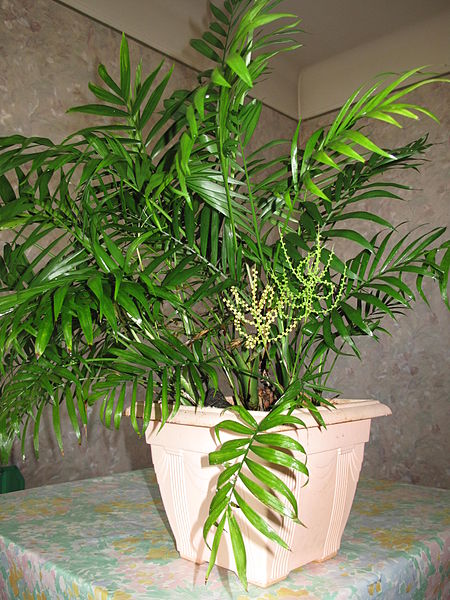
It is used in gardens in sub-tropical climates, such as the Southeastern United States, and in tropical areas, growing to 6-7 feet tall inside, ( may reach about 12 feet outside in zones 9 and higher ) with slender, cane-like stems.
It is often cultivated in temperate regions as a houseplant, where it grows to 6 feet tall with very slow growth, tolerating low levels of humidity and light, though it prefers medium to high humidity and bright indirect light.
It is a versatile and almost no-maintenance plant that is able to grow in most indoor and outdoor conditions. These plants are not tolerant of frost and must be kept indoors in winter in non-tropical climates.

Also called the Cascade Palm, it produces large, dense clusters of trunkless plants, about 4 feet tall, with soft, dark green leaves. It is one of the best palms for indoor decoration, but will also do well in warm temperate or tropical gardens, in both shady and sunny spots.
Cat Palms can tolerate cold down to 25°F and is great for growing in USDA Zones 9b-11.

A shade loving palm particularly suited to growing in pots either indoors or on patios and verandas. Named 'Bamboo Palm' due to its multi-stemmed growth habit, resembling that of bamboo. A great air-purifying plant for indoor spaces and offices.
It can be grown outside in zone 9 and higher, but is most commonly found as houseplant or patio plant.

Teddy Bear Palms are very drought tolerant, and does not need much water at all once it has established itself. It is good to water it regularly for a start to give it a boost, and also make sure you fertilise it regularly, and mulch it well. This palm grows best in full sun to light shade, and needs a well draining soil. Will tolerate cold down to about 32 degrees, this is a palm best suited for warm climates and heated greenhouses.

Chinese fan palms do well in full sun and are used in masses in both outdoor landscapes and interior spaces. Young plants like it better with part shade. The leaves are magnificant and may grow up to 5 feet in diameter and form a dense canopy on a solitary brown trunk. Small specimens look great in pots and planters while mature plants make a nice specimen in the landscape. Flowers are not significant but large bunches of fruit are spectacular.
Hardy for zones 8-11.

A mature palm can grow from 30 to 60 feet. It also makes a wonderful patio container plant for many years. This is usually a stout tree to 50 ft. tall, with a trunk to almost 3 ft. in diameter. Large, blue-green, fan-shaped leaves, up to 3 ft. wide, are divided into many palmate segments. The leaf stalk is stout, equally or exceeding the leaf in length. Dark purple fruits hang in showy clusters.
The wood is resistant to decomposition and shipworms, making it desirable for use in wharf pilings and fence posts. The leaves are used for thatching and making straw hats. The drupes and palm hearts are eaten. For zones 8-11

The large leaves have a dull finish and are a medium green, sometimes yellow-green, in color depending on the individual and situation. Each leaf is up to 12 feet long overall including the spineless petioles (leaf stems) which measure about 5-6 feet in length. They are up to 6 feet in width with drooping leaf segments about 3 ft (0.9 m) long and 2-3 in (5.1-7.6 cm) wide. These segments are split to about half the width of the leaf and typically slough off tan fibers at the edges. Cabbage palm leaves are said to be costapalmate meaning that the leaflets are arranged on the stem in a pattern that is midway between palmate (leaflets arranged like the fingers on the palm of your hand) and pinnate (feather shaped).
Unlike the royal palm, the cabbage palm has no crownshaft. Leaves emerge directly from the trunk which is often covered with old leaf stem bases that are arranged in an interesting criss-cross pattern. Depending on the individual these may persist to the ground even in very old palms. Other trees in the same vicinity may shed their leaf attachments or "boots" as they are sometimes called very early in life revealing a rough fibrous brown trunk. Eventually the trunk will age to gray and the surface will become smooth.
The cabbage palm's creamy white flowers are arranged on a long branched inflorescence that appears in summer. In mid-summer the cabbage palm bears creamy white flowers on a long branched inflorescence that is held completely within the crown. Flowers are followed in late fall or early winter by black spherical fruit that is about one third of an inch in diameter. Inside is a shiney brown seed that is about one quarter of an inch in diameter. Squirrels, raccoon and many other species of mammal and bird enjoy visiting the cabbage palm for dinner feasts of fruit and seed.
This southeastern U.S. native palm occurs near the coast, from the North Carolina barrier islands to South Carolina, to Georgia, down to the Florida Keys and then up the Gulf Coast to the northwestern Florida panhandle. Sabal palmetto is also native to Cuba and the Bahamas. It is often planted all along the Gulf Coast. Cabbage palm occurs along beaches, sandy bay and estuary shores. It inhabits the margins of tidal flats and marshlands where it often crowds into extensive groves. It's also encountered inland in hardwood hammocks and pine flatwoods.
Sabal palmetto is very salt and drought tolerant and can be used in beachside plantings. It is able to adapt to most types of soil. Cabbage palms are easy to transplant if they have at least six feet of trunk.
Requires Full sunlight to some shade. Trunk development is suppressed in heavily shaded specimens. Average moisture will do. Tolerates drought, standing water and brackish water. Hardy to USDA Zones 8-10. This is a hardy frost tolerant palm that can survive many degrees below freezing.
Two cabbage palmettos shade a bayside picnic area while framing Tampa Bay's Sunshine Skyway Bridge. The cabbage palm is used as an ornamental and street tree, well adapted for group, specimen or avenue plantings. This palm is very salt tolerant and can be grown on the beach or directly at the water's edge of bays and inlets. The state of Florida has been planting cabbage palmettos by the hundreds along the state's freeways. The palm groves refresh the eye and absorb the road noise providing a calming influence for both motorists and the environment. Cabbage palm is very low maintenance and drought resistant making if a perfect choice for urban plantings.
Young potted cabbage palms will take up to ten years before they begin to form a trunk. They grow slowly these first years as root system and the crown forms. Once the trunk does begin to develop the growth rate increases somewhat. The growth rate of cabbage palm can be significantly increased with regular watering and feeding.
Cabbage palm is the state tree of Florida and is displayed on the state flag of South Carolina whose nickname is the "Palmetto State". The durable trunks are sometimes used for wharf pilings, docks and poles. Brushes and brooms can be made from young leaves, and the large fan shaped leaves have been used by the Seminole Indians in Florida as thatch for traditional pavilions, called chickees.

This species is best suited for subtropical and warm temperate climates, but it has been successfully cultivated in areas such as central Tennessee and the greater Washington, DC Metropolitan area. Sabal minor is a recommended horticultural plant and is a popular choice for coastal resort areas from Virginia Beach to southern Texas. Get your Sabal minor Dwarf Palmetto today and bring a unique touch of nature to your landscape.



Flowers are followed by green round fruit that turns white when it is ripe. Fruit is around 1-1.5 inches wide.
This slow growing palm can get up to 15 feet tall. It likes full sun but can also grow in broken shade. It does best in moist sandy soil with good drainage. Like a lot of palms it likes humid weather. It tolerates salt and drought very well. It adapts to a lot of different conditions.
This palm is not very cold hardy palm; it can tolerate cold down to 30F. The Thatch Palm is a wonderful palm tree in any landscape, especially those landscapes which love to adorn a hammock. Thatch Palm Tree can also grow indoors very easily. The almost-circular leaves can reach a diameter of 3 feet, and were used by early inhabitants as roofing material.

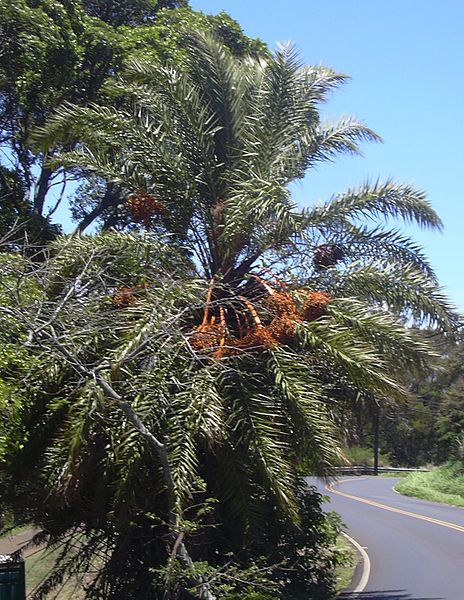
Zones 8b and higher.
Unusual shaped foliage and stems that are slender and jointed bamboo like. This is a very unusual palm that requires warmth. Difficult to germinate and raise, but well worth the effort.
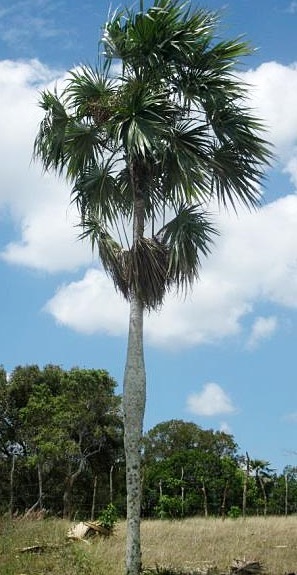

It makes a good houseplant if grown in small tubs and a great patio plant if brought in during cold weather, it does not like tempeatures below 50 degrees. Zones 10b and higher outside, most commonly grown as houseplant or patio plant in cooler zones.

Endemic to Madagascar, this rainforest dweller thrives in sheltered, warm, humid, and per-humid areas near the coast, anywhere from sea level up to 3000 ft. The Traveller's Tree is known to produce an edible seed, used locally, and often grown for its striking ornamental value.
Traveller's Tree is a pollinator hub, attracting a multitude of pollinators like lemurs, bats, and birds. Fascinatingly, in full bloom, a new flower opens every 2-3 days, predominantly at night, resulting in a stunning floral display.
Despite its grandeur, this evergreen marvel does take up to 10 years before flowering. However, it's the foliage rather than the blooms that draw people to this magnificent tree. Therefore, if you're seeking a breathtaking feature for your garden or landscape, look no further than the Traveller's Tree.
For zones 9b and above outside.

During the summer season the queen decks herself out with impressive infloresences. In early winter she takes on a sporty look when huge amounts of fruit appear. Bright orange 1 inch oval "dates" hang in impressive 6' bunches creating a colorful show.
Full sun is best but will tolerate some shade.
It will withstand some drought but keep watered for best looks and fastest growth. Hardiness:USDA Zones 9-11. Cold damage appears at 25°F, the plant freezes and dies at about 20°F.

One of the slowest growing palms in the palmae family. Very similar to its brother the Windmill Palm (Trachycarpus fortunei), the Miniature Chusan Palm has distinctive characteristics that differentiates it from the Windmill Palm. The Windmill Palm (Trachycarpus fortunei) has and overall appearance of being more dainty and leggie.
The Miniature Chusan Palm (Trachycarpus wagnerianus) has and overall appearance of being more compact. It has smaller leaves that are much more stiff and deeply-cut. The leaves are green to dark green in color and are rounded in outline and held on shorter stems. Therefore having shorter stems they are more resilient and will not bend under the weight of snow or ice. The Waggie Palm is very cold hardy withstanding temperatures down to 0 degrees and below with little to no damage. It has shown no leaf damage in Zone 6 and will make it through anything this climate can throw at it.
The Miniature Chusan Palm is also disease free and worry free. This palm enjoys full sun to partial shade and will do best with well drained soils. It is adaptable for both containers or gardens, making it the ideal choice for the tropical look with no worries of freezing cold temperatures.
This palm tree will make a great addition to any home office or landscape. It will give a sense of the tropics with little cost.
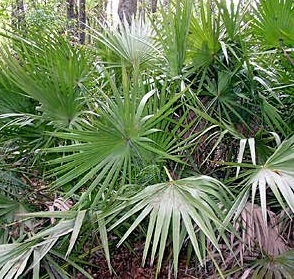
Saw palmetto occurs naturally on the coastal plain from
South Carolina to southeastern Louisiana. It grows in a wide
range of habitats from seaside sand dunes and dry scrub to
moist forests, pine flatwoods and even wetlands. Saw palmetto
can be the dominant ground cover in certain southeastern pine
forests, sometimes covering hundreds of acres. Culture: Once
established, saw palmetto is virtually maintenance-free.
Light: Prefers full sun, but can tolerate partial sun.
Moisture: Tolerates drought but can also tolerate moderately
moist soils.
Hardiness: Fully hardy to zone 7, this palm has been seen
growing in zone 6, but does suffer foliage damage at 10 degrees
F. and complete foliage loss at 3-5 degrees F.
Saw palmetto is a beautiful little palm and richly deserves a place in the ornamental landscape. Plant saw palmettos in front of clumps of larger palms, or even underneath large palms. They look good massed in clumps in mixed borders, or as framing hedges. Use as accents to trees or in foundation plantings.
Features: The berries of saw palmetto are used as a treatment for Benign Prostatic Hyperplasia or enlarged prostate gland. They are also used as a diuretic to tone the bladder, improve urinary flow, and decrease urinary frequency. They may help prevent prostate cancer.
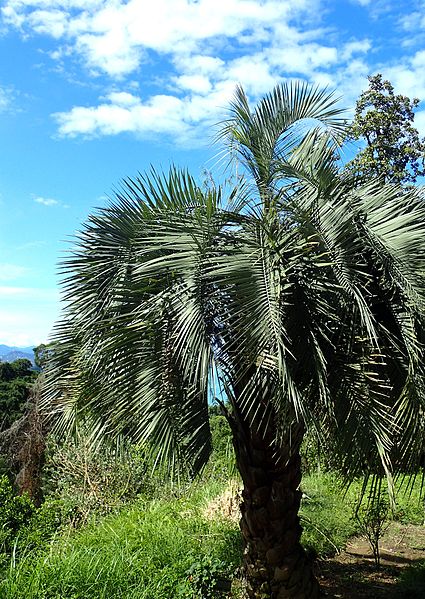
Grown regularly in zone 8, this palm has been proven to survive 0° F. when heavily mulched and protected. Generally considered safe to grow in zone 7 if heavily protected, it is suspected it could survive zone 6 under certain conditions.

It produces bright orange fruit, called pindo dates in the US, and as Jelly is made from these it accounts for the common European name,'Jelly Palm'. Although the fruit is supposed to be delicious, there seems little evidence of it being grown commercially as a fruiting palm. The flowers are numerous, very small, creamy yellow and are borne on 3-4 feet long inflorescences bearing separate male and female flowers. Pollination is by wind and insects.
The 1" yellow to orange fruits are round or oval shaped, and hang in large bunches. Each fruit contains a single large seed which looks like a tiny Coconut, with the characteristic 3 pores at one end. The sweet, but tart, flavour is a mixture of apricot, pineapple and banana. Fruits are harvested as they ripen, or if the whole bunch is harvested they tend to ripen all at once. They can be eaten fresh or puree'd, and make excellent jelly as well as wine. They can be stored for about a week refrigerated.
Cold hardy to about 10 degrees for short periods of time.

The Palm was originally introduced to Los Angeles to beautify the town for the 1932 Summer Olympics. Many Palms planted then in Los Angeles are near the end of their natural lives and are fully mature. Most of these trees are not being replaced with other Mexican Washingtonia Palms but with other full-spread trees like oak trees and sycamores which trap more air pollution and provide more shade.
From Los Angeles the Palms began to spread to other areas in the U.S.A.. Unlike Washingtonia filifera, which has been cultivated as far north as Oklahoma and Southwestern Utah, the Mexican fan palm can be grown mainly around areas of the southwestern United States, such as California and the coast of Oregon, Arizona, Southern Nevada, and New Mexico. It may also be seen along the Gulf Coast from Texas to Florida and may also be found in coastal Georgia and South Carolina.




Regardless of age or size, Cycas revoluta is one of the easiest plants to grow, indoors or out, by beginner or expert. This subtropical adapts to a wide range of temperatures from 15 to 110 degrees F (-11 to 42 degrees C), accepts full sun or bright interior light, thrives with attention, and tolerates neglect. In addition, Cycads are extremely long-lived. A 220 year old specimen of Encephalartos, a relative of Cycas revoluta, is on display at the Royal Botanic Garden, Kew England; the restoration of the famous Palm House required it to be temporarily transplanted to a holding area for more than a year; the move was successful and is an example of the durability of these ancient "living fossils".
This is an excellent opportunity to raise these expensive plants yourself for less than a buck a plant.
These are fresh seeds that will germinate in a few months. If kept in the refrigerator, these seeds will remain viable for over a year.
Excellent container plant or outside garden plant for warm climates.
Jim's Notes:
Give roots ample room to grow by picking a pot or container that is a minimum sixteen inches deep or more.
The Sago Palm can be grown inside the house near a bright window. Like other cycads, they do not want to be over-watered.
Let the soil dry out a bit before watering.
Try to avoid overhead watering; this may cause rot and possibly total decay of the plant. The soil mix should be quick draining.
The plants are quite cold hardy and can tolerate temperatures below 20°F. Overall, it is an outstanding species that is quite versatile and easy to grow. It is usually free from pests but can occasionally get into problems with scale or mealy bug, which should be treated.
Fertilizing with a balanced tropical fertilizer with microelements will usually suffice. Sagos typically throw a new set of leaves during the Spring or Summer.
It is quicker and easier to grow Cycas revoluta in the ground as opposed to a container. In general, Sago Palms need sun to grow well. In coastal areas, it is best to plant them in full sun.
In more interior locations or desert localities, they still prefer good sun or at least part day sun. Growing the Sago Palm in the shade typically gives one lanky, stretched-out leaves that are weak.
If in too much shade, this species can actually just stall and do nothing (such as refusing to throw any new leaves).


Trunks are usually covered with a loose mat of coarse gray or brown fiber. In older individuals the fiber sloughs away to reveal a smooth ringed surface.
Has light to dark green palmate leaves that are lighter, almost silvery (glaucous), on the underside.
It is commonly grown as a landscape specimen in central and northern Florida, the southeastern U.S. Atlantic and Gulf Coasts, and in mild areas along the west coast. It has been sighted in northerly latitudes from Charlotte, North Carolina to Atlanta, Georgia to Vancouver, British Columbia.
This palm makes a great accent which fits well into small areas like courtyards and entries. It is a tough plant and survives in hot urban landscapes and even thrives there if watered and fed. This palm is perfect for containers if care is taken that they are well drained.
Hardy to zone 7b.


Small black colored fruit with a taste resembling a date in clusters.
Endangered in its own habitat on the Guadalupe Islands, this palm is becoming popular in other parts of the world. The sweet pulp from the fruit adds to its attraction, along with its bluish-green fan leaves. It grows to 30 feet tall and drops its dead leaves forming scars on the trunk where the leaves once were. It takes full sun with occasional summer water and does well along the coast.

It will grow about 15 feet tall outside, but makes a wonderful patio plant when young. Cold hardy to about 25 degrees.

It is widely cultivated in subtropical and warm temperate regions and is surprising cold hardy capable of surviving freezing temperatures down to 28 degrees.

Jim's Plant Growth Stimulator
To see the results for yourself, we advise using it on some plants and not on others and see the difference.
Note: We only ship this product to addresses inside the USA. The following ingredients are used in making Jim's Plant Growth Stimulator:
Gibberellic Acid
Gibberellic Acid is EPA approved, and is commercially used to grow most fruits and vegetables we eat.
B1 Vitamins and Plant Hormones
Micronutrients
Other ingredients
Each 8 ounce bottle of JPG01 Plant Growth Stimulator makes 16 gallons spray-on solution, you can also use a drench and pour it around the base of the plant if you prefer. The bottle comes with a 1/2 ounce measuring spoon, simply mix a half ounce of plant growth stimulator with a gallon of water and spray onto the plants, or drench the soil around the plant. :



